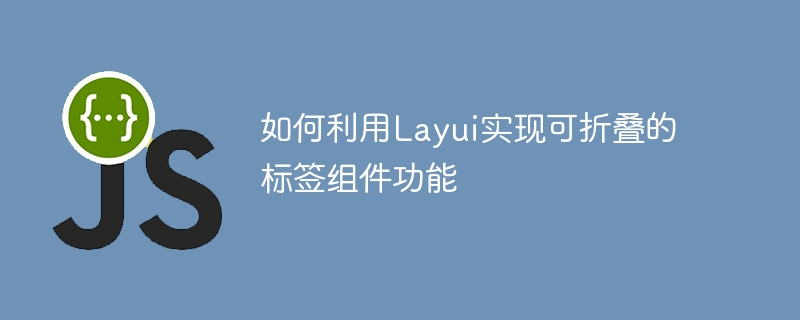Home >Web Front-end >JS Tutorial >How to use Layui to implement the collapsible label component function
How to use Layui to implement the collapsible label component function
- WBOYWBOYWBOYWBOYWBOYWBOYWBOYWBOYWBOYWBOYWBOYWBOYWBOriginal
- 2023-10-24 12:27:11810browse

How to use Layui to implement the collapsible label component function
In front-end development, we often encounter situations where a large number of labels need to be displayed. If we directly display all labels Displayed, it will not only take up a lot of page space, but also make the page look cluttered. In order to solve this problem, we can use the folding panel component provided by the Layui framework to implement the collapsible label component function. Next, let us learn how to use Layui to implement this function.
First, we need to introduce Layui related resource files, including css and js files. It can be introduced in the following ways:
<link rel="stylesheet" href="layui/css/layui.css"> <script src="layui/layui.js"></script>
Next, define a container in the page to place the label component. For example:
<div id="tagContainer"></div>
Then, write JavaScript code in the <script> tag, and use Layui's folding panel component to create a collapsible label component. The code example is as follows: </script>
layui.use(['element'], function(){
var element = layui.element;
// 定义标签数据
var tags = [
{name: '标签1', content: '标签1的内容'},
{name: '标签2', content: '标签2的内容'},
{name: '标签3', content: '标签3的内容'},
// 这里可以继续添加更多标签
];
// 生成标签组件
var tagHtml = '';
for(var i = 0; i < tags.length; i++){
tagHtml += '<div class="layui-colla-item">';
tagHtml += '<h2 class="layui-colla-title">' + tags[i].name + '</h2>';
tagHtml += '<div class="layui-colla-content">' + tags[i].content + '</div>';
tagHtml += '</div>';
}
$('#tagContainer').html(tagHtml);
// 渲染组件
element.init();
});In the above code, we first use the layui.use method to load Layui's element module. Then, we define a set of tag data, including the name and content of the tag. Next, we generate the corresponding HTML code based on the tag data and add it to the tag container. Finally, render the accordion panel component by calling the element.init() method.
Finally, we also need to add some styles to the generated label component so that it displays and collapses correctly. You can add the following CSS code to the page:
.layui-colla-item {
margin-bottom: 10px;
}
.layui-colla-title {
background-color: #f2f2f2;
padding: 10px;
cursor: pointer;
}
.layui-colla-content {
padding: 10px;
display: none;
}In the above CSS code, we added some basic styles to the label component, including setting the background color of the title, setting the padding of the content, and hiding the content.
Through the above steps, we have successfully implemented a collapsible label component using Layui. Users can click on the title of each tab to expand and collapse it. This saves page space and makes the page clearer and easier to read. I hope this article can help you understand and use the folding panel component provided by Layui.
The above is the detailed content of How to use Layui to implement the collapsible label component function. For more information, please follow other related articles on the PHP Chinese website!

